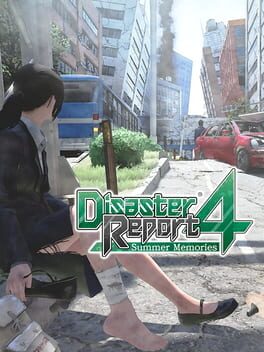Despite having never finished a Disaster Report game, I love this franchise a lot. It’s the exact kind of niche, jank nonsense I’m a complete sucker for. Ridiculous melodrama, goofy acting, poorly animated visuals… it’s got it all! After the 2011 Tōhoku earthquake and tsunami, however, it seemed likely that the franchise was dead. Studio Irem shut down and it’s devs left to make studio Granzilla. The PS2 era was over and these kinds of goofy C-tier games didn’t have a space to exist anymore.
Which is why it’s kind of stunning this game exists at all, much less is as compelling as it is.
The ThorHighHeels video review covers the topic in much more detail and I’ll hit a lot of the same points here, but I need to convey my thoughts down anyway or I’ll melt. Even so, I highly recommend checking his analysis out.
Like all Disaster Report games, the set-up is straightforward. There’s a disaster. You need to survive it. Gather resources, make ethical decisions, press a button to brace for earthquakes. Previous entries often involved a vast conspiracy, with some villain creating an artificial flood or earthquake for their own evil ends.
Disaster Report 4 sheds that angle though and goes for a quiet character drama. The disaster is natural. There’s no mastermind. It’s just you and thousands of others trying to survive an awful situation. You can tell that the 2011 disaster actually impacted how the team was approaching these stories. Rather than a lot of high-octane chases, a lot of the game is about traveling around and visiting different tragedies or morality plays. You find people price gouging on emergency supplies or using the chaos to support their own vices. You can also find communities binding together and cutting down old barriers in favor of overcoming these tremendous odds.
I think the most striking, and probably controversial, sequence of the game is the Miracle Water subplot on Day 4. You’ve reached an elementary school that’s been turned into a shelter. But the community is distrustful of outsiders, particularly foreigners. Immigrants from outside the country are forced to sleep in the parking lot and the playground rather than indoors with the others. After grabbing some water and helping some of these children, rumors start to spread about the “Miracle Water.” Before long, before you can stop it, you’re being hailed as a messiah by those same racist community members. The game never lets you correct them but it’s hard not to see an advantage in keeping up the con. They’re giving you food to give to the children. They’re letting outsiders sleep indoors. If you’re playing an immoral play through, you can even get a sailboat out of it to escape from the city. And people are happy. Is it that bad a lie?
Things break bad eventually and the chaos that emerges is genuinely upsetting. You’re chased out of the shelter and one of the immigrants is brutally assaulted by the angry mob. It’s horrifying and sickening and it left an awful pit in my stomach that AAA games haven’t ever done to me. Until the epilogue section, I was actually pretty sure he was murdered. While not being able to stop the lie could be annoying, the lack of control makes it more effective as an extreme action somewhat might take in upsetting circumstances. It’s a genuinely engaging story about how desperate people buy into cults and myths, a story of racism, and about the stress of disaster. When an actual villain does emerge in the climax, their motives and beliefs seem more believable because of plots like that. The villain commits some horrible crimes, and justifies it to themselves by pointing to angry mobs of normal people like we’ve just seen. “These people seem civilized, but it’s no different from the war zones I grew up in. Distrust of outsiders, selfish behavior, falling for cons out of desperation… it’s all the same”
But even with how bleak that sounds, this is a light game in the end. While you can do horrible things, the game actually gives you plenty of ways to turn those bad actions into good deeds. In fact, that’s encouraged for a player that wants to see everything. Steal thousands of dollars from a cult? Pay off people’s loans, save the orphanage, support communities. It’s also still a VERY silly game. You can run around in a chef or superhero or whatever costume through all these scenes. You can convince a con artist that you’re Mary Crawford. You can blackmail the mayor to change the game’s title, which permanently changes the loading screens to “Disaster Report 5?” The optional epilogue becomes a fighting game in the climax and the protag finishes it up saying “oh the ending song is playing.” Even with its shift to a character drama, the game hasn’t left its roots.
There’s a couple narrative threads that don’t ultimately go anywhere as part of the game’s chaotic nature. A subplot about a shady business only wraps up in the epilogue. The epilogue is packaged with the main switch copies, but it looks like the PC and PS4 version has the epilogue as paid dlc. Truly bizarre choice.
A brief confession. If a Switch game wasn’t made by an indie studio, I probably pirated it. I won’t explain how. 13 Sentinels, Kirby, and Animal Crossing I bought legally, the latter mainly for online services. Otherwise, I really try to avoid paying $60 for a game.
But… I might go legally buy this? I don’t know if or when I’d play this again, but this game just stuck with me in such a way that I feel like I want it on my shelf in a permanent way. It’s such a fascinating experience.
